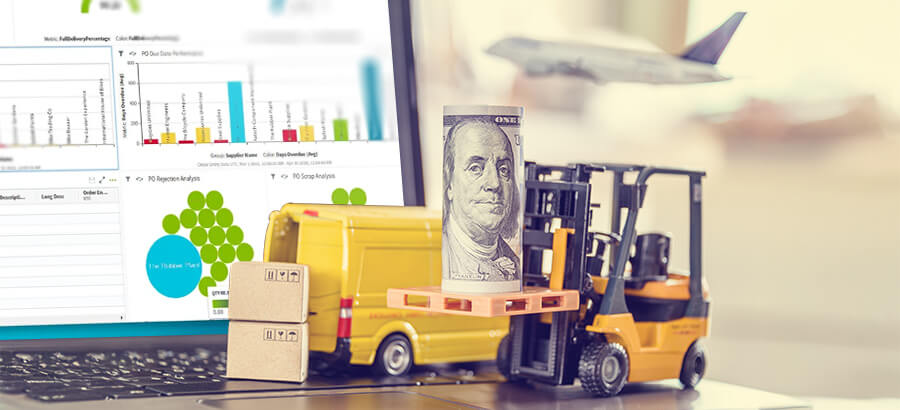After you have implemented an ERP solution, how can you translate that into savings? An ERP system helps you work more efficiently, quickly and accurately. It provides the visibility needed to control costs and enhance customer service.
An ERP application also provides the backbone for finance transformation. According to Gartner, “CFOs are entering a period of significant transformation for finance, with new technologies readily available to help drive efficiencies and insights into business performance.”
Where ERP saves money
Instead of paying for different systems to handle various parts of the business, an ERP system handles many changing parts of the process simultaneously, reducing overall staff workload (and costs) and minimizing system expenses. In addition, automation of daily tasks leads to increased production and more accurate output, which allows for better business planning, and therefore longer term cost reductions.
We expect the cost benefits generated by the scheduling and labor modelling components alone to realize improved operating expenditure of around $1.5 million to $2 million each year.
– Frank Patton – Chief Financial Officer, Ruprecht
An ERP solution can deliver benefits in several areas.
- Inventory management
Inventory costs are found in the carrying cost of having inventory, and in handling like shipping and receiving. An ERP system helps with automating processes, and with better reporting and forecasting, and can keep inventory carrying costs to a minimum.
- Inventory Reduction
Through improved inventory management that an ERP system delivers, a company can significantly reduce inventory. This cascades into lower warehousing costs, handling and transportation, and reduced damage and less obsolete stock. One such estimate has shown an overall saving in inventory and its management of around 30%.
- Inventory Turnover
With an ERP solution, a business can increase inventory turnover by ensuring the inventory that is in stock is really required. Some estimates give an increase in turnover going from 2.5 times a month to 3.1.
- Warehousing Efficiency
An ERP system can streamline warehousing and storage by recording key information of products – their location within the warehouse, specific storage requirements, and instructions such as handling needs.
- Material cost
Using an ERP system can lead to improved procurement practices through more accurate forecasting. Orders can be placed in time and emergency purchases (which can be costly) avoided. As a result, the purchasing department is able to obtain better terms and conditions from suppliers. If your ERP system includes a supplier portal, your suppliers can get accurate up-to-date information on your purchasing requirements, which means they can plan their production better and can pass on some of the savings to you. Estimates are that the improvements in purchasing can lead to a 5% reduction in purchasing costs.
- Supply chain management
Supply chain management is improved with an ERP solution. Better control over the supply chain helps reduce waste and time delays. From ordering, to warehousing, to inventory control and shipping, costs are better managed with better control of the supply chain.
- Information flow
Because an ERP system centralizes and consolidates data, it provides better reporting capabilities. Coupled with automated notifications and task management, this results in a smoother, faster flow of information across the organization. This means people can make more informed decisions, which ultimately will have cost implications.
- Customer service levels
By improving inventory management and using data for better forecasting, a business can deliver to the customer as and when required, avoiding lost sales and reducing stockouts. For longer lead-time stock items, an ERP system can report on available and inbound stock to ensure customers receive up-to-date and accurate information on availability.
- Sales
Another benefit of an ERP solution is better coordination between production and sales. For sales, getting information from the factory about availability means information to better manage the lead time to ship orders, and new customer requirements can be priced and produced quickly.
By allowing them access to see their orders online, customers can find out costs and specifications directly. This also allows them to alter their demands fairly late into the production cycle, improving customer loyalty. This usually means increased sales and better customer retention. Everyone knows it’s cheaper to keep a customer than to find a new one.
- Manufacturing labor costs
By implementing an ERP system for the manufacturing environment, work schedules can run more efficiently with fewer outages and interruptions. This translates to a reduced need for re-work and less overtime. Better forecasting of demand and improved workflow means a smaller number of rush jobs. This reduces the requirements to change machine set-ups and improves the factory throughput. This adds up to lower production costs and better quality. It has been estimated that a properly implemented ERP system on the factory floor can bring down direct and indirect labor costs by as much as 10%.
- Accounting and Cash Flow
Delays in the cash cycle can increase costs. An ERP application can speed up the invoicing process and improve the cash cycle.
Using an ERP system in accounting can reduce the number of days outstanding of accounts receivable and so improve cash flow. It can enable better follow-up on outstanding or delinquent accounts. It can also help to plan cash utilization much better through more accurate forecasting.
Intangible cost improvements
Besides the fairly easily measured improvements, there are improvements that are more intangible in nature but are equally important.
In the next three to six months, we expect to see working capital savings in between $100,000 to $250,000. We are already saving over 95% of work hours.
– Stephen Kay – Director Logistics, Arjo Canada
Process design and production
An ERP system allows better control over process design and production. It ensures that any planned changes to product specification are controlled and do not create inconsistencies in design. This results in greater stability and agility of the manufacturing process, and avoidance of costly problems.
Accounting Procedures
Since an ERP application consolidates data into a common database, there is no longer any need for duplicate accounting files. This improves accuracy and speeds up the accounting process. Product costing is streamlined and there is better visibility of cost structures (material, production, labor).
As each order moves through the production chain, records are automatically generated and the general ledger is kept updated. This improves the accuracy of control, timeliness of reports, and the quality of the decisions can be improved.
Guidelines for managing costs
Gartner recommends that CFOs implement a cost management framework – a set of cost categorizations that are used in budgeting, target setting and reporting on costs. They have found that organizations using a cost management framework:
- experienced stronger cross-functional collaboration on cost management;
- were more likely to achieve their cost management goals.
A major obstacle to improved cost management are functional silos. Using an ERP system can help break down those silos and promote a formal cost management framework.
Promoting cost consciousness
A recent Gartner study found that 69% of board directors say that the effects of the pandemic have accelerated their digital business initiatives. The challenge for CFOs is how to fund these initiatives while maintaining control over costs. It’s crucial for a business to understand what its individual cost structure is. This is achievable with an ERP system. The system can be used to improve cost awareness and promote a cost-conscious culture.






